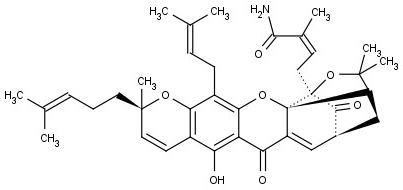|
Related Topics: |
|
|
|
Current News |
|
Chemistry A to Z |
|
About Internetchemistry |
Gambogic Amide |
|
Researchers have identified a compound in tree bark that mimics the chemical reactions of a naturally occurring molecule in the brain responsible for stimulating neuronal cell signaling. Neuronal cell signaling plays a crucial role in the growth, plasticity and survival of brain cells. The tree bark compound, known as gambogic amide, behaves much like Nerve Growth Factor (NGF), a molecule found in the brain. NGF binds to TrkA, a neuronal receptor, and activates neuronal signaling. It is known that the loss of TrkA density correlates with neuronal atrophy and severe cognitive impairment such as that associated with Alzheimer's disease. Because gambogic amide also binds to TrKA and activates neuronal signaling, the researchers believe it may have potential as a therapeutic treatment in people affected by neurodegenerative disease, such as stroke, Alzheimer�s disease and peripheral diabetic neuropathies. |
|
Results of the study are published online in the Proceedings of the National Academy of Sciences and will be published in a future print edition. The research was conducted by Emory University scientists Keqiang Ye, PhD, associate professor of pathology and laboratory medicine; first author Sung-Wuk Jang, PhD, and Masashi Okada, PhD, post-doctoral fellows in Dr. Ye�s lab; Iqbal Sayeed, PhD, instructor; Donald Stein, PhD, Asa G. Candler Professor of Medicine; and Peng Jin, PhD, assistant professor of human genetics; and Dr. Ge Xiao at the Centers for Disease Control and Prevention. Gambogic amide is derived from gambogic acid, a major ingredient of gamboges, a brownish-orange resin exuded from the Southeast Asian Garcinia hanburryi tree. The resin has been used in that area of the world for thousands of years to treat cancers without any reported toxicity to noncancerous cells. "Humans actually have a naturally occurring molecule in the body, Nerve Growth Factor (NGF), which stimulates the growth and differentiation of certain types of nerve cells. However, NGF has poor pharmocokinetics and bioavailability when synthetically manufactured and used therapeutically, and it is also expensive to produce," Dr. Ye says. "Previous research had focused on copying the chemical structure of NGF, but the cyclopeptide mimetics are not potent enough to use as a therapeutic agent. Instead, we decided that we needed to identify a more robust molecule that would pharmacologically mimic NGF's effect on brain cells by binding to TrkA. What we came up with was gambogic amide." Dr. Ye says. The researchers are now conducting further pre-clinical research to investigate how the body processes gambogic amide and to confirm that it is in fact non-toxic. This study was supported by the National Institutes of Health. |
|
|
|

